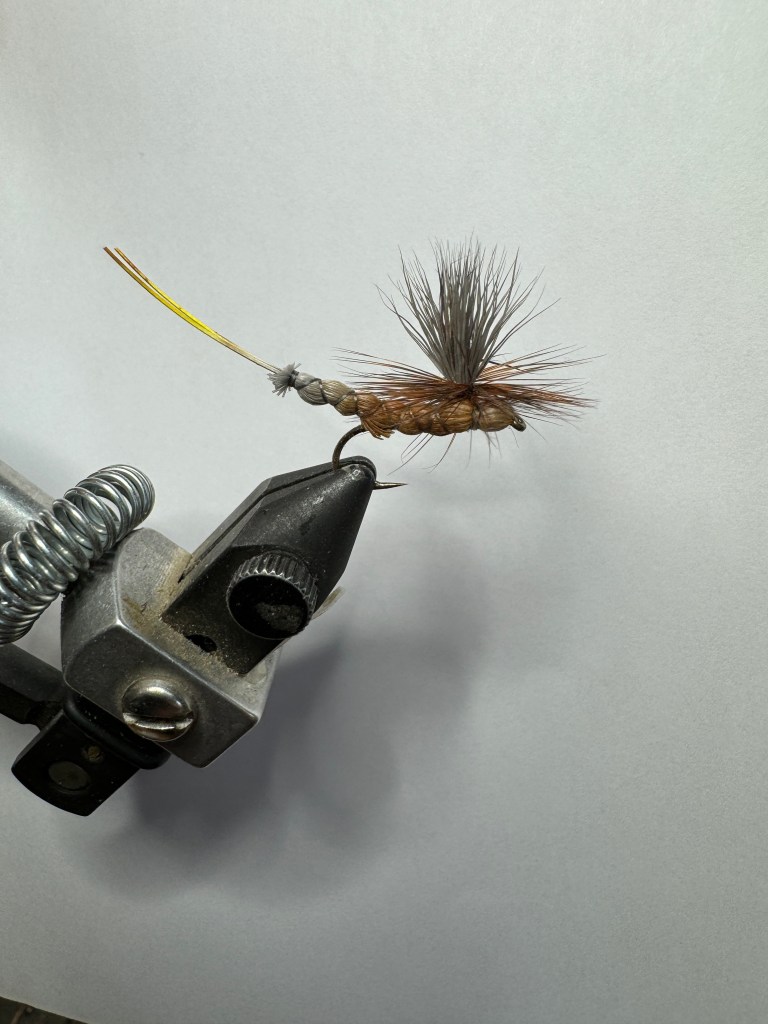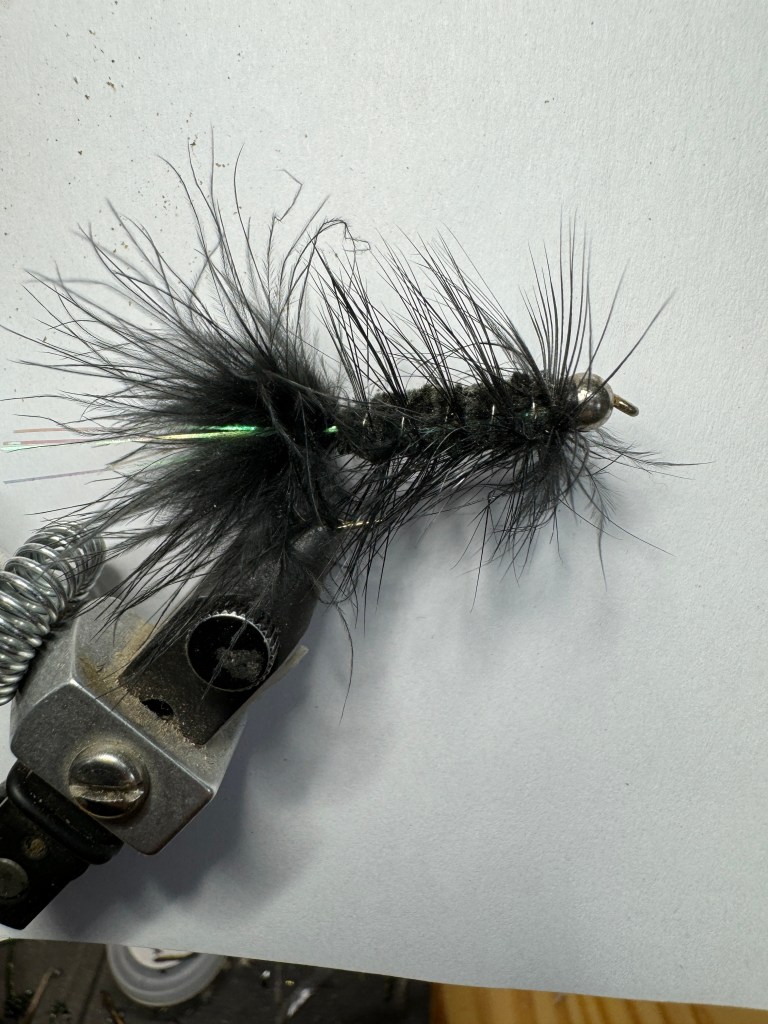Kansas is a great place to fly fish because of the varieties of fish you can catch. Bass, walleye, crappie, and every other species that live in Kansas water can be caught fly fishing. Since fly rods are typically much longer and have much lighter action than conventional fishing rods, catching a small fish can feel like you’ve caught a whopper.
Spring is a great time to learn how to fly fish in Kansas because bluegill, which are ounce-for-ounce the feistiest fish in the water, are close to the shoreline of most ponds or lakes. Tie a small popper on the end of a fly line, flip it out a few feet from the bank and be ready to tie one on with a ferocious fighter that makes you think it’s a monster.
The difference between fly fishing and conventional fishing
Flies

The most significant difference between fly fishing and conventional fishing is the weight of the lure. In conventional fishing, the weight of a lure or a sinker tied on to the end of the line is what pulls the line off the pole when you cast it, so you cast the lure. However, in fly fishing, the lure – although they are referred to as “flies,” are often so tiny that a dozen of them will fit on the head of quarter. Flies have almost no weight, so they do not have the ability to pull the line off the reel when you cast it.
Therefore, in fly fishing, it is the line weight of the line that carries the fly to the target, so you cast the line, not the fly. If you’ve ever watched a fly angler, you see them moving the rod back and forth in an 10 o’clock and 2 o’clock position because they are using the rod’s action to create the distance, they need the line to be to reach their target. When the angler pulls the rod back to the 2 o’clock position, they are “loading” the rod with tension in one hand and creating slack in the fly line in the other Then, on the forward cast, the tension in the rod pulls the slack out of the line and shoots it towards the target. Sometimes, to reach a target, a fly angler will make several back-and-forth motions, each time shooting the line out a bit further.
Rods
Fly rods come in various weights and lengths depending on the size of fish you intend to target. For example, a 2-weight rod is matched with a 2-weight line and a 5-weight rod is matched with a 5-weight line. The smaller the number – like a 2-weight – is great for small fish like bluegill. A 5-weight is the most common one for starters and, for those who go after bigger fish like bass and carp, an 8 or 9-weight is preferred.
Line
Unlike conventional fishing line which sinks, most fly lines for beginners are buoyant. These “floating” lines are various colors and are designed to have a “leader” tied on to the end. That leader looks like regular fishing line, except they are “tapered” which means that one end is thicker than the other so as it stretches out over 7 to 9 feet, it tapers to down. The purpose for this tape is so the fly lands gently on the water.

Types of flies
Fly anglers prefer the use of flies rather than lures because most flies are designed to mimic the life cycle of aquatic insects. When you go to purchase flies, you will discover a variety of sizes and patterns, which are tied using feathers, fur, deer hair and other materials with the attempt to make the fly look like one of the three basic stages of an insect: larvae, pupa and adult. A female Mayfly, for example, lays her eggs in the water where they will live for up to three years and, once they began to hatch from the egg, they begin to grow their wings and, upon reaching the surface, fly away. They live above the surface water for 24 hours, land on the water to lay eggs, then die.
Dry flies –
These are flies designed to stay on top of the water, like the Mayfly mentioned above who has grown wings to fly. For most fly anglers, dry fly fishing is the most fun because the fish rise to take the fly and that action can be exhilarating as a fish explodes out of the water. Terrestrials like grasshoppers, ants and June bugs, which hatch on land and fall into the water are also classified as a dry fly.

Nymphs –
A nymph is a catch-all term for the life cycle of the insect before it reaches the surface. As you shop for flies, you will begin to discern between dry flies and nymphs because its obvious one can float and the other cannot. While dry-fly fishing is the most fun, fishing a nymph below the surface usually catches more fish.

Streamers
Streamers are meant to replicate small fish and are fished by “stripping – short tugs on the line while it’s being retrieved to mimic the action of small fish. A Wooly Bugger and a Clouser Minnow are the two most popular types of streamer patterns and come in a variety of sizes an color combinations.

Poppers –
Called thus because the make a “pop” when given a sudden jerk, these topwater flies are designed to attract fish with noise. Although patterns can be varied from cork-poppers with concave faces to mouse patterns, their primary purpose to use the noise of something plopping in the water or trying to swim to attract fish.

Where to fish
Any body of water that holds fish is a place to fly fish in Kansas. The Kansas Wildlife and Parks intentionally create fishing opportunities both by creating public access to lakes and rivers, they also have an intensive stocking program designed to populate the bodies of water they manage with an abundant supply of fish. Their website, www.ksoutdoors.com, is a plethora of information of the places you can fish. Most stores who sell fishing equipment have the KDWP Fishing Atlas which is a tremendous resource.
I recently discovered a new resource that connects anglers to privately owned ponds and streams in Kansas, The Land Trust. I connected with Tim and Rhonda Boughner of Dabar Creek Ranch near Benton and spent a morning fly fishing their stocked pond of bass, bluegill and channel cat. The Land Trust – www.landtrust.com – is an AirBnb-like model where landowners offer their property for hunting or fishing for a certain fee for a certain time period.
Farm pond fishing like that is one of the more enjoyable fly-fishing experiences you can have, but just make sure it’s not surrounded by a bunch of trees to tangle up your back cast or fish it from a float tube.
How to fish
Learning how to cast is easy but takes instruction. There are a variety of fly-fishing groups and dedicated fly shops in Kansas that have excellent teachers. If y
Bank fishing – since fly casting requires as much distance behind you as in front of you, it’s imperative that you fish from banks with no trees or brush behind you.
Float tubes – my favorite, these inflatable one-person units are great to kick around the water in, going places you just can’t reach from the bank. Important note, ALWAYS wear a flotation device while in a float tube.

Boats/Kayaks – another great way to access water, a boat or kayak gets you into places you can’t reach from the bank.
You don’t have to go to high mountain trout streams to find some of the most enjoyable fly fishing that’s right in your back yard.
Learning to fly fish
Flatland Fly Fishers’ Club, Wichita – https://flatlandflyfishers.org/ This active club is comprised of newbies to the sport as well as some of the best fly anglers in Kansas who are always eager to introduce people to the sport. They also offer a class at WSU, Fly Fishing 101
K & K Fly Fishers, Kansas City – http://kkflyfisher.com/
Ark River Anglers, Wichita – http://arkriver.com/ArkRiver/
Wander Woman Kansas – https://www.wanderwomanks.com/
Fishing’s Future, Kansas – https://fishingsfuture.org/chapters/
Vamos a Pescar – https://www.takemefishing.org/
Other fly fishing articles I’ve written on this website:

